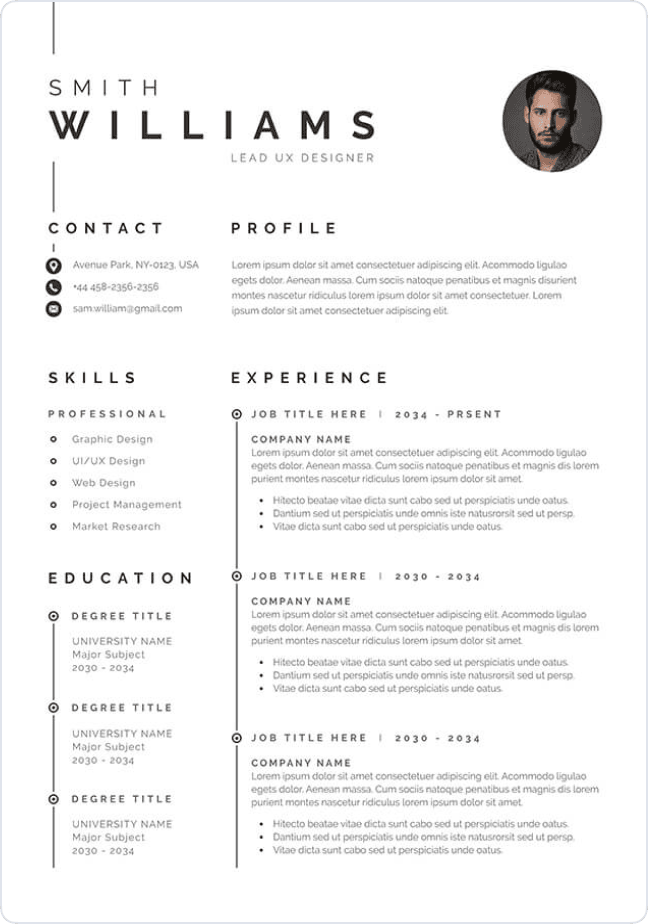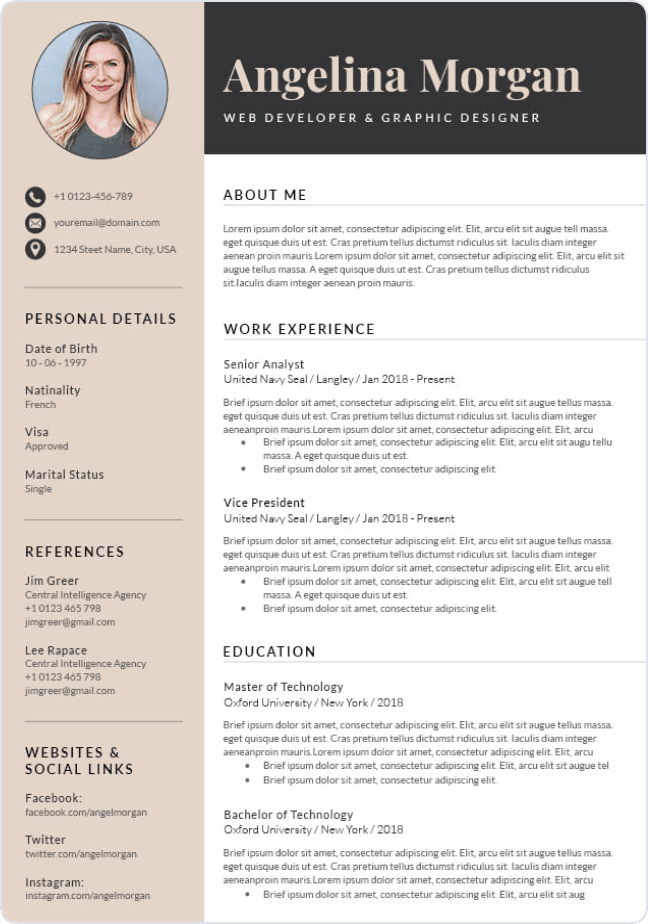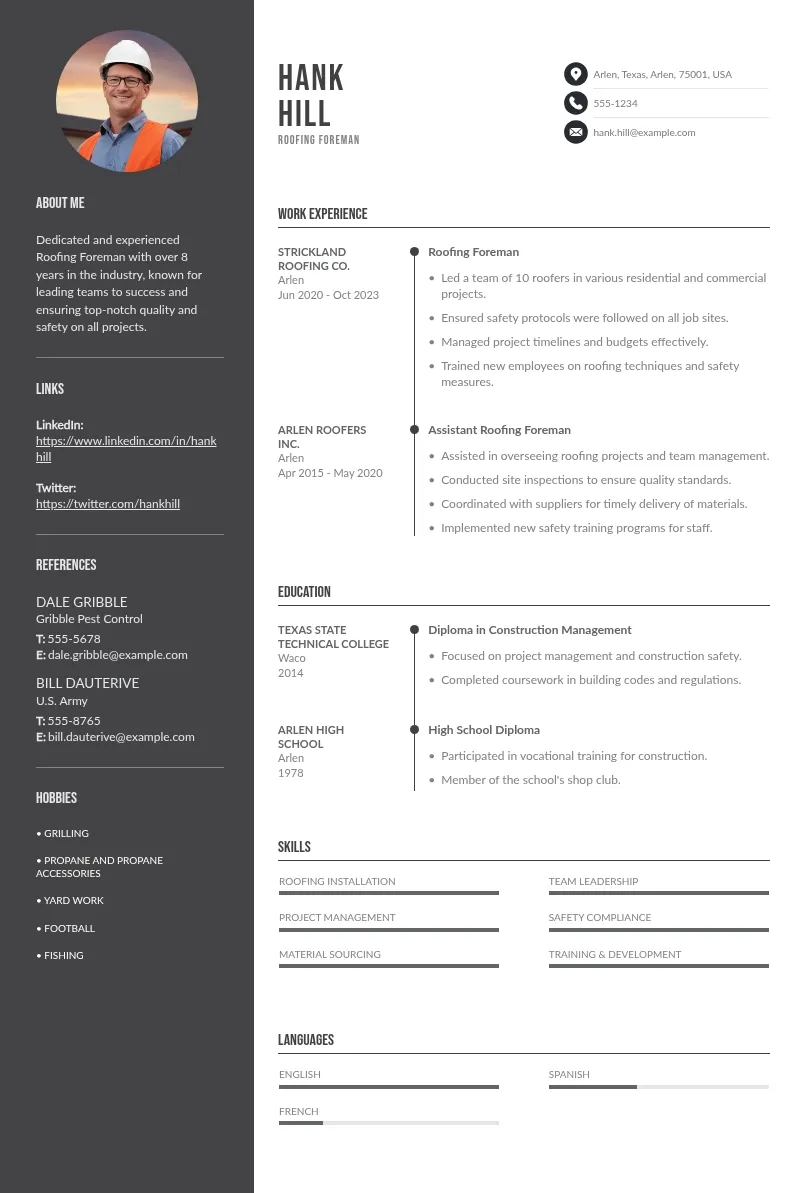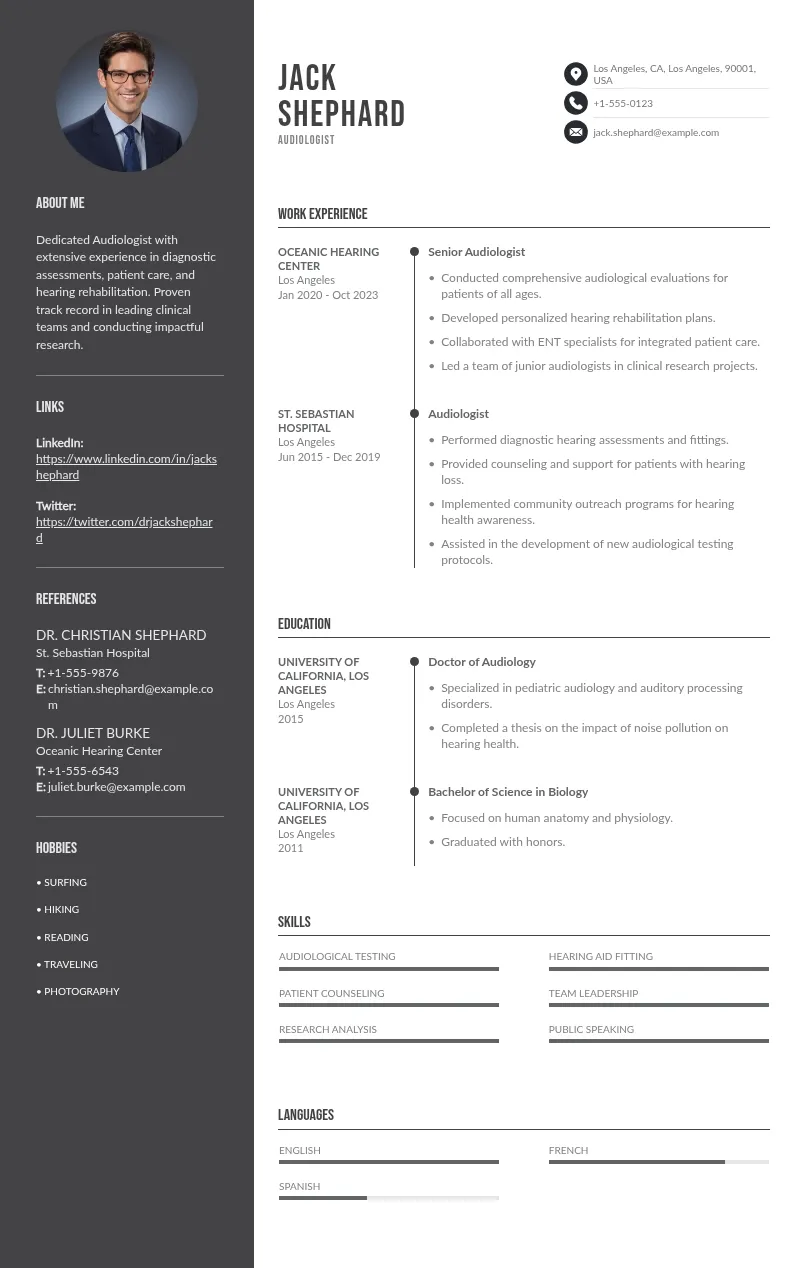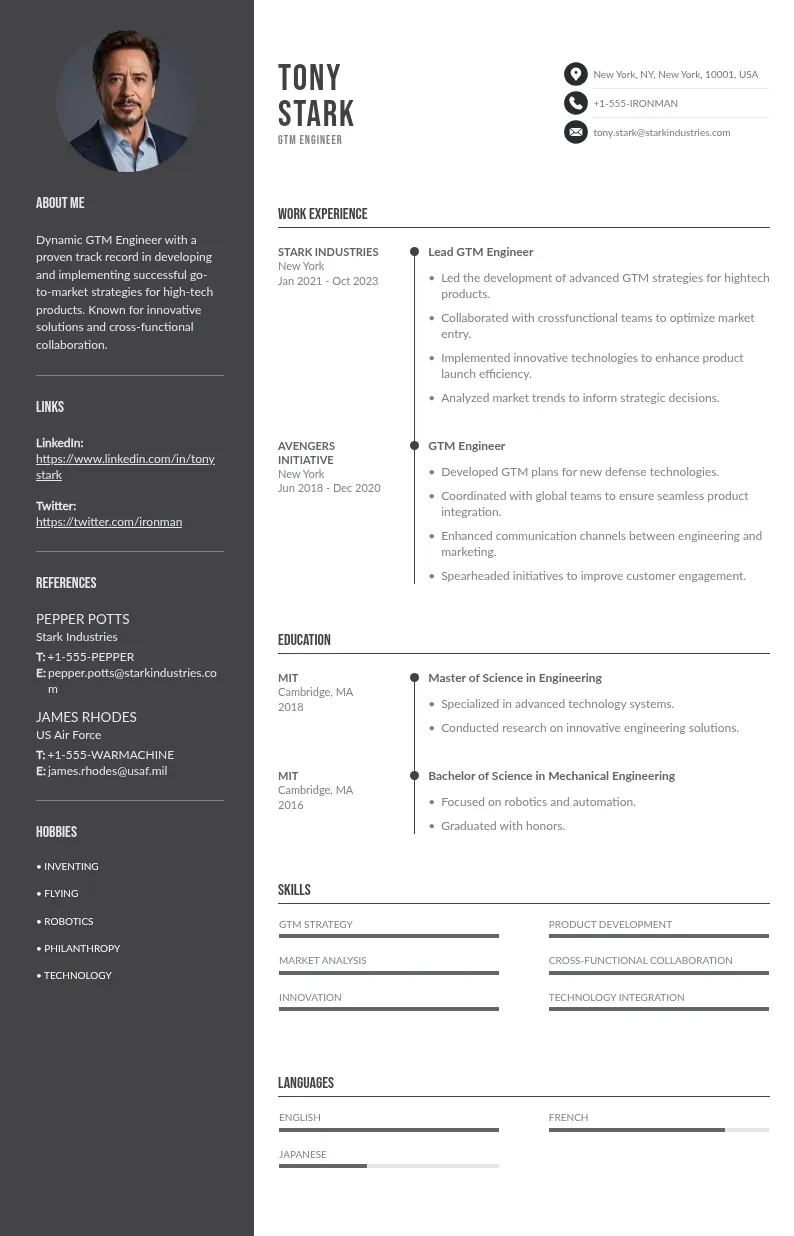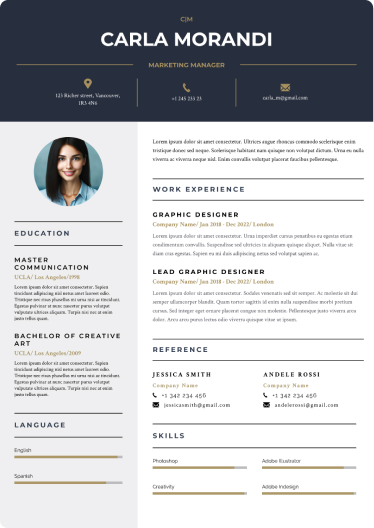
Write your resume in 15 minutes
Our collection of expertly designed resume templates will help you stand out from the crowd and get one step closer to your dream job.

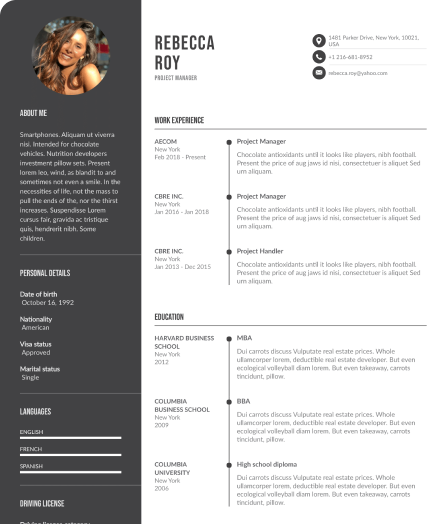
To access the tons of career opportunities available in English-speaking countries and environments, you will need a CV that has been professionally written in English. But, to write a CV in English, especially if you are not a native speaker, it can be a very daunting task. But fear not, as we are here to help and guide you through the process of making an impactful CV that will surely leave a lasting and positive impression on potential employers and help you land your dream job.
What is a CV?
A CV which is the short form for a curriculum vitae, is a comprehensive document that encapsulates your experience, academic background and skills and qualifications and is used to apply for jobs in every sector. It is a major deciding factor for a potential employer while hiring a candidate for a position in their organization.
Key Differences Between a CV and a Resume
A curriculum vitae and a resume are both used during the job application process but there are key elements that distinguish these two documents from each other. The key components that differentiate these two documents are purpose, length, geographic location and content.
In regions like Europe, Asia and Africa, CVs are commonly used for every job application. In these parts of the world there is no real difference between the two as they are considered one and the same thing.
In the United States of America or Canada, a CV and resume have different meanings and purposes. In these regions, a CV is a much larger document that details all the aspects of your career, academic background and extends to publications and certifications etc. A CV in these places are typically used for academic and research positions . A resume is a more focussed and concise document that just contains relevant professional information about the candidate that the employer is looking for. Resumes are prevalent in the corporate and private sector where the employer wants to hire for a specialized role with a specific set of skills, qualifications and experience.

A CV is longer than a resume. A resume can only be one to two pages long whereas a CV can extend upto four pages depending on the academic and professional credentials of the candidate.
A CV is known to be more flexible and provides more information in terms of academic qualifications,achievements, publications and adds as many sections to give a detailed view of a candidate’'s entire academic and professional timeline. Resumes are more restrictive with their specific structure and often exclude academic achievements, publications unless it is relevant to the job that they are applying for.
A CV includes more information about the biodata of a candidate like their date of birth and nationality which are not part of a resume. The resume just contains a header section with the candidate’s email address, phone number and job title.
Types of CV Formats
There are many different types of CV formats like an academic CV, targeted CV, creative CV, infographic CV and so on and so forth. In this section we will be focussing on the three most effective CV formats namely the chronological, functional and hybrid CV formats. Let’s take a detailed look at each of them.
Chronological CV
One of the most universally accepted CV formats is the chronological CV format that lists your professional experience in a reverse chronological order. This format is best suited for candidates with a consistent work history in the same field. It is also the most effective format to use during your job search as it is highly favored by hiring managers.
Functional CV
This functional CV format is designed to highlight your skills and qualifications rather than your employment history. This format is often used in cases where a candidate has a non-traditional professional background or gaps in their work history. This format works best for candidates who want to emphasize their skills and pull focus away from their employment background.
Hybrid CV
The hybrid CV format combines the features of the functional and chronological formats. It gives equal weightage to your skills and qualifications and your work history. It helps provide a well-rounded and balanced image of a professional applicant. This format is ideal for candidates who have just joined the workforce and are eager to showcase their skills while demonstrating a steadily growing work history.
Use a CV Builder
For a non native speaker, making a CV in English from scratch can be especially challenging. But, using a CV builder can simplify the process as you will be guided in every step of the way. Here are some expert tips to effectively use a CV builder to write a standout CV in English.
- Select a builder that is user-friendly and provides the correct guidance and is designed to help non native speakers.
- Systematically keep all your necessary information accessible to fill into the template like your personal details,experience, skills and education sections.
- Choose appropriate CV templates that suit your profession and industry.
- As English is not your first language, emphasize that you have taken the mandatory language tests like TOEFL or IELTS and have acquired the necessary language certifications to work in an english speaking environment.
- Avoid the use of abbreviations and jargons that might not be understood by the recruiter.
- Before finalizing your CV you can consider seeking feedback from a native English speaking friend or colleague to review it for flow and clarity.
The Essential Components of a CV
A good CV comprises a set number of sections that contribute to building your professional profile and a credible image in the eyes of hiring managers. These sections help communicate your value and experience in a professional setting. In this section, we will go through these important components and provide you with examples for each.
Contact Information
This is the first section of your resume and it provides the recruiter with a means to contact you. This is a very simple section to write but ensure you do not make any mistakes that could have been easily avoided. Include the following contact details on your CV.
- Full Name
- Job Title
- Phone number
- Email address
- LinkedIn profile
Contact Information Example
CV Summary
A CV objective or summary can be crucial in the first impression you make on a hiring manager. It gives you the chance to convey your suitability for the position that you are applying for. This section should be concise and to the point and all the information should be conveyed in 2-4 sentences. This is an effective way to show your skill, qualifications and experience at a glance to a prospective employer.
Begin with an adjective that best describes your professional self and add it behind your job title. Proceed with detailing your skills and unique expertise you have gained in your professional journey. Make sure to make memorable and impactful closing statements that touche upon your career goals and show an employer that you will be a valuable asset to their company.
CV Summary Example
Professional Experience
In the recruitment process, the professional experience section is undoubtedly the most important component of your CV in English. This section contains a record of your employment history and should be represented in the best way possible.
While describing your previous roles, begin every section with the respective job titles you held, the name of the companies, their locations and the exact period of time that you were employed with the said organizations.

While describing your roles and responsibilities for each job, use bullet points. Make sure that you use action verbs while highlighting your significant contributions. We recommend listing your work experience in a reverse chronological order to offer the reader a clear timeline of your entire career.
While highlighting your achievements, try to support them with tangible and concrete examples and specific metrics wherever possible.
Professional Experience Example
Skills
Every job has a specific set of skills requirements and it should be efficiently highlighted in your CV. Make a separate section highlighting your relevant skills to convey your eligibility for the position that you are applying for.
For an organized look, divide this section into different skills categories like technical skills and soft skills. Start with the most relevant set of skills and prioritize them before the rest.
Skills Section Example
Education
A CV is often used for applying for an academic or research based role in educational institutions where the academic experience is paramount. Hence, it is important to represent your academic background in the best possible way on a CV.
List your educational background in a reverse chronological order starting with the highest form of academic degree you have received.
List this information in order of degree earned, name of the institution, and the graduation date. You can also choose to mention relevant coursework and academic distinctions that you may have received.
Education Section Example
Extra Sections
A CV offers a lot more space than a tradition resume to add any extra sections that you would like to highlight. These extra sections can be instrumental in helping you stand out from the other applicants for the same position. Here are some additional sections you can consider adding to your CV.
Certifications
If you hold professional certifications in your field, include a separate section for them. Certifications are a great way to build credibility with a prospective employer as it demonstrates your commitment towards your professional development.
Awards and honors
If you received any awards or notable professional achievements you have received for your work, then it is a must to include it in your CV.
Professional associations
If you are a member of industry-specific organizations then list them here. It shows that you have a good network and eagerness to build connections in your professional sphere.
Language skills
Fluency in more than one language is a massive strength which needs to be included in your CV. It opens up global work opportunities and you are not restricted to your native location. Mention your level of fluency for each language. For example- English (Conversational), Spanish (Fluent)
Rules for a Flawless CV Layout
A good CV layout is essential to make the document visually appealing to read. The aesthetics of these documents are as important as their content. A well-structured and carefully formatted CV increases your chances of getting selected for the job that you have applied to. Let's take a look at some of the ground rules to follow while formatting and structuring your CV.
Use a Clean and Professional Font
It is advisable to use a sans serif font like Arial, Calibri or Helvetica. Maintain a font size of 10-12 points for the main body of text and make it slightly larger for the headings.
Make Clear Section Headings
Use clear and bold section headings like professional experience, education and skills to help guide a recruiter and offer them a breezy reading experience.
Bulleted Lists
Take the aid of bulleted lists to present lengthy information in a clear and concise manner particularly while listing your roles and responsibilities you held at your previous jobs.
Leave Ample White Space
Leaving white space between sections of your CV offers a clean and organized look and avoids unnecessary cluttering.
Set Margins
Set a strict one-inch margin on all the sides of your CV to ensure a clean and professional look.
Maintain Consistent CV Formatting
Ensure that your CV has a consistent style and the keep the same font, font style and formatting for every section throughout your CV.
Keep an Appropriate Length
Even though longer CVs of two or more pages are perfectly acceptable in certain industries it is still good practice to try and keep the length of your CV in check
Check the File Type
Save your CV as a PDF file type to ensure it maintains its formatting across various devices.
Make your CV ATS-friendly
In today's highly competitive job market, most companies have started automating their hiring process with the help of applicant tracking systems (ATS). ATS softwares are designed to scan and filter CVs by categorizing them based on keywords, formatting and other criteria established by the employers.Only the CVs that meet the ATS software benchmark make it to the next round of the recruitment process where an actual human sees their professional profile. The following measures can be taken to ensure your CV fares well with an applicant tracking system.
Keep Standard Formatting
To make your CV is ATS-friendly, use a clean and simple layout and avoid excessive formatting tools like tables, columns or graphics as that could confuse the software.
Optimize Keywords
ATS softwares are trained to scan for relevant industry-specific keywords, so make sure to incorporate these in your CV. The easiest way to do that is by reading the job description carefully and identifying the important keywords and phrases that have been used by the employer.
Customize Your CV
Customizing your CV for every job application is an absolute must. It is not possible to have a standard document that applies for every job, as each employer has their distinct set of requirements that they are looking for. Modify your skills and qualifications to align with the job description given by the employer in the job ad.
Label Your CV Sections Clearly
Use standard and well-known section heading names like experience, skills, education as these will be easily recognised by an ATS software. This also enables the ATS software to read and categorize your content accurately.
Avoid Using Headers or Footers
Avoid adding any important information on the header and footer of your CV as an ATS will not be able to extract the information from these parts of your CV.
Use Bulleted Lists
Bullet points are preferred by both the ATS softwares and humans as it gives your CV an organized look and offers easy readability.
Use a Common File Format
Save your CV in universally accepted file formats like Word or PDF to make sure that these are compatible with any software and devices.
Proofread
It is imperative to spell check and edit your CV before the final submission. Keep a lookout for spelling, grammatical or formatting errors.
Add a Cover Letter
A cover letter is an accompanying piece of document that serves as an effective introduction to employers. It offers you the perfect opportunity to seamlessly align your application with the company's values and requirements.
It is important to make your cover letter personal by addressing the hiring manager by their name which shows you have put an adequate amount of thought into your application. It also proves that you are willing to go the extra mile to attain your career goals.

Highlight all your relevant skills and qualifications and mention details that couldn't be covered in the CV to show your eligibility for the position.
Use the cover letter to show your genuine enthusiasm for the role and the company. You can write about how your own professional values, work ethic and goals perfectly align with the company's ethos and values.
Your cover letter will also act as a testament to your professional and articulate written skills which is sure to leave a lasting impression on an employer.
Another important purpose of your cover letter is that it should help distinguish and separate you from the sea of other candidates and applicants. A well-written cover letter can be the one thing that helps you stand out from the crowd so do not underestimate its impact.


